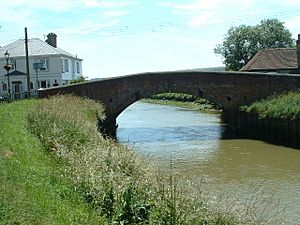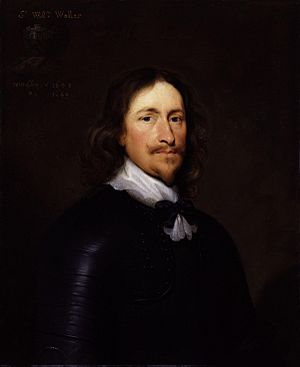Battle of Bramber Bridge facts for kids
Quick facts for kids Battle of Bramber Bridge |
|||||||
|---|---|---|---|---|---|---|---|
| Part of the First English Civil War | |||||||
 The modern bridge over the River Adur at Bramber |
|||||||
|
|||||||
| Belligerents | |||||||
| Commanders and leaders | |||||||
| Colonel Joseph Bampfield Sir William Butler |
Captain Morely Sir Michael Livesey Captain James Temple |
||||||
| Strength | |||||||
| 600 | 2,000 | ||||||
| Casualties and losses | |||||||
| 8-9 killed | 1 killed 1 captured |
||||||
The Battle of Bramber Bridge was a small fight during the First English Civil War. It happened on December 13, 1643. Soldiers loyal to the King (called Royalists) tried to take a bridge in Bramber, West Sussex. This bridge crossed the River Adur. However, a group of Parliamentarian soldiers (called Roundheads) was already there.
The Royalists tried to find another way to cross the river. But they soon got news that the town of Alton had been lost that same night. So, they were told to go back to Arundel.
Why the Battle Happened

When the war began in August 1642, Parliamentarian forces controlled most of southern England. This included important ports like Southampton and Dover. They also controlled most of the Royal Navy. When Portsmouth gave up to William Waller in September, Parliament controlled all major ports from Plymouth to Hull. This stopped the Royalists from bringing in weapons and soldiers from Europe.
However, in 1643, the main Parliamentarian army was stuck near Oxford. On July 13, 1643, Ralph Hopton, a Royalist leader, badly defeated Waller's army. This happened at Roundway Down. This made it harder for Parliamentarian groups in the west. On July 26, the Royalists captured Bristol. This opened a way for them to get help from Ireland.
At the same time, some Parliament members wanted to make peace. To keep fighting, the Royalists decided to first capture Gloucester. This would give them more control of the west. Then, they planned to attack London. Hopton was supposed to threaten London from the south. He would move into Hampshire and Sussex. This could stop the Wealden iron industry, which made weapons for Parliament.
Hopton's army faced problems like not enough money or supplies. Also, Irish soldiers, who were a big part of his army, were delayed. So, he could not move until mid-October. By then, the Royalists had left Gloucester. Their attack on London was stopped at the First Battle of Newbury on September 20.
In early November, Hopton's soldiers reached Winchester and refused to obey orders. Order was restored only after some soldiers were punished. This gave Waller time to gather a new army. This army was made of local soldiers from London, Kent, Sussex, and Hampshire.
Hopton moved towards Farnham but could not get Waller to fight. So, he pulled back. The Royalists set up winter camps in West Sussex and Hampshire. These places included Alresford, Alton, Petersfield, and Midhurst. But Hopton's officers warned him that these camps were too far apart to help each other. In early December, the small group of soldiers at Arundel Castle gave up to a Royalist force. This force was led by Colonel Joseph Bampfield and Edward Ford.
The Fight at Bramber Bridge
Colonel Bampfield left Ford to build defenses around Arundel. Bampfield took 400 foot soldiers and 200 cavalry (horse soldiers). Their goal was to capture Bramber and its bridge over the River Adur. Controlling this bridge meant controlling the road into East Sussex and Lewes. This would stop attacks from that direction. Sir William Butler, a Royalist whose property had been taken by Parliament, joined Bampfield.
Bampfield's group marched all night. But when they reached Bramber, they found the bridge was already held. Soldiers from the Kent Trained Bands were there. They were led by Sir Michael Livesey and James Temple. Temple was in charge of nearby Bramber Castle. This castle was old and not useful for defense. So, it is likely he had built defenses around the bridge itself.
The Royalists had hoped to take the bridge quickly and secretly. But they could not attack the Parliamentarian positions. They suffered some light injuries from musket and cannon fire. While looking for another place to cross, Bampfield received an urgent message. Hopton told him about the Battle of Alton and that it had been lost the night before. Bampfield was told to return to Arundel right away. Arundel was Waller's next target. He also had to send any spare troops to Hopton.
What Happened Next
The Battle of Bramber Bridge was the last military fight in that immediate area. It was probably the furthest east a Royalist army reached during their 1643 invasion. Even though parts of Kent and Surrey fought in the Second English Civil War in 1648, Sussex and Hampshire stayed mostly peaceful.
This small fight was mentioned almost a month later. A letter from John Coulton to Samuel Jeake of Rye, dated January 8, 1644, briefly described it:
The enemy attempted Bramber Bridge, but our brave Carleton and Evernden with his Dragoons and our Coll.’s horses welcomed them with drakes and musketts, sending some eight or nine men to hell (I feare), and one trooper to Arundel Castle prisoner, and one of Capt. Evernden’s Dragoons to heaven.
This letter shows that the writers supported Parliament. They said Royalist soldiers went to "hell" and their own soldiers went to "heaven." One Royalist soldier was taken prisoner to Arundel Castle. "Drakes" were small, lightweight cannons used to fight groups of people. This means the Parliamentarians might have used these cannons to defend Bramber Bridge.

